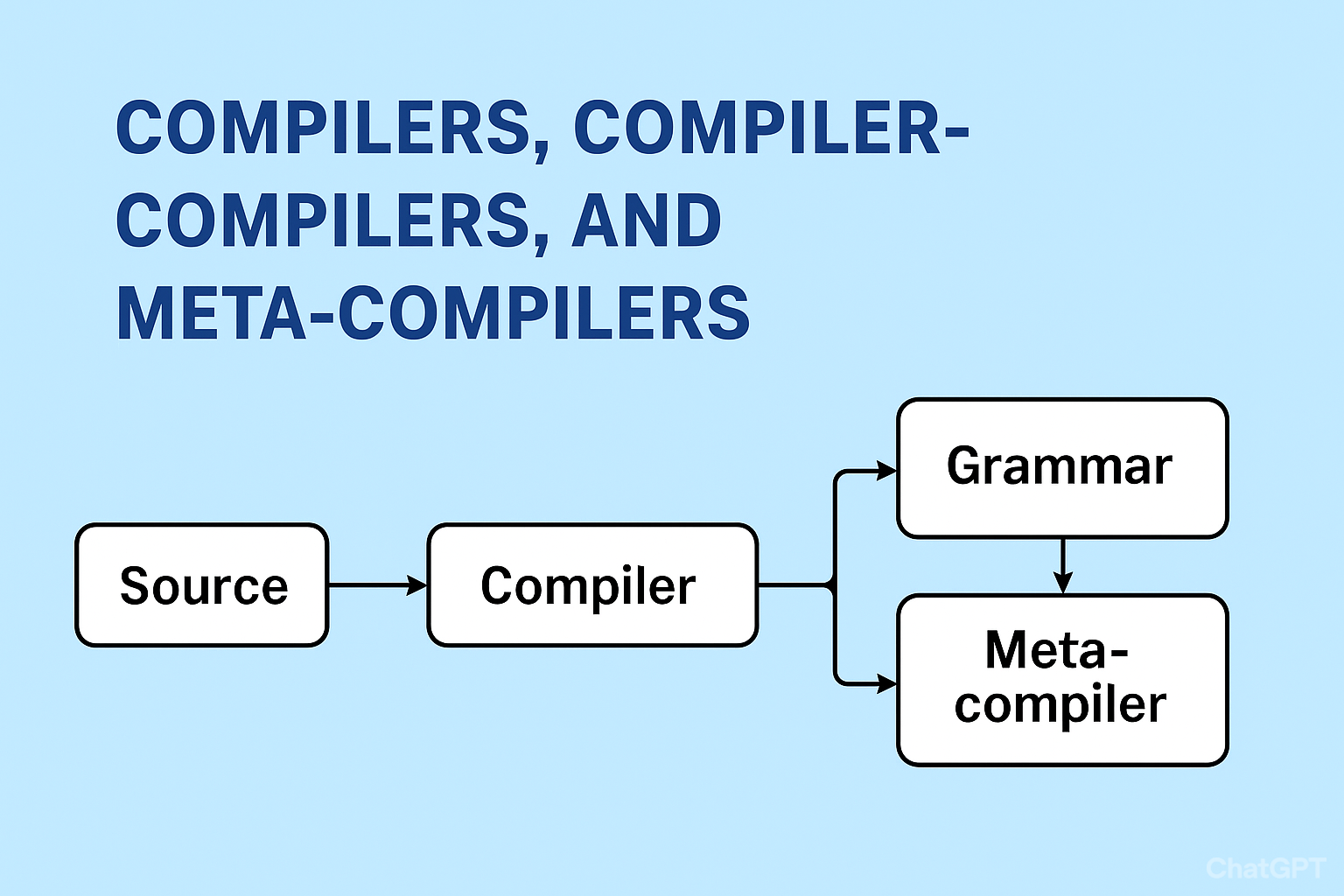What is compiler-compiler? how to develop compiler
Compilers, Compiler-Compilers, and Meta-Compilers — A Practical Guide
What they are, how they differ, why you might use each, and practical examples and diagrams to help you design or choose the right tool for building a language or translator.
Quick table of contents
2. The canonical compiler pipeline (diagram)
3. What is a compiler-compiler (parser generator)?
4. What is a meta-compiler? (history & Forth practice)
5. When to use which (practical decision guide)
6. Real examples and modern twists (LLM & meta compilers)
7. Minimal “starter” recipes and references
1. What is a compiler?
A compiler is a program that translates source code written in a high-level language into another form — commonly machine code or an intermediate representation (IR) that later becomes machine code. Compilers not only translate text, they also check and transform the code (lexing, parsing, type checking, optimization, and code generation). This is the foundation for almost every language toolchain. ?2?

Short form: a compiler maps source ? semantics ? target. The mapping must preserve program behavior (modulo defined undefined behavior), and often adds transformations that improve performance or ensure safety.
2. The canonical compiler pipeline (walkthrough)
The common decomposition into stages is:
- Lexical analysis — tokens from characters.
- Parsing — tokens ? AST (syntax tree).
- Semantic analysis / type checking — ensure well-formedness, resolve names, check types.
- IR lowering — convert to intermediate representation.
- Optimization — local/global transforms for speed/size.
- Code generation — IR ? assembly or bytecode.
- Linking / packaging — combine with runtime or libraries.
These stages can be split, combined, or repeated; modern modular compilers (LLVM, GCC) expose IRs to enable reusable passes.

3. What is a compiler-compiler (parser generator)?
A compiler-compiler is a tool which takes a grammar or a description of a language and produces parts of a compiler (often the parser and sometimes lexers and other scaffolding). Famous examples include Yacc, Bison, and ANTLR. The idea is: instead of writing the parser by hand, you give the grammar to a generator that creates the parsing code.
Advantages:
- Speeds up the front-end creation.
- Less boilerplate; grammar is declarative.
- Well-tested generator code yields reliable parse behavior and error reporting.
Limitations: for highly context-sensitive languages or tricky error recovery you may still want a hand-written parser. ?6?

4. What is a meta-compiler?
Meta-compiler is a term with a couple of historically related meanings; the core idea is “a compiler that helps build compilers” or “a compiler that can compile its own description.” Two common senses:
- Compiler-compiler / meta-language lineage: the Schorre META family (META I, META II, etc.) produced metacompilers that read grammar/metalanguage specs and produced compilers for target languages. These were sometimes called metacompilers in classic literature. ?8?
- Self-hosting / Forth usage: in Forth and some embedded systems, a metacompiler refers to a system that compiles definitions of the compiler itself (or compiles a kernel of Forth into machine code), sometimes cross-compiling or bootstrapping a new implementation. Practitioners often call that “meta-compilation.” ?9?
Crucially, a metacompiler can be used to:
- Generate whole compilers (not just parsers) from high-level descriptions.
- Bootstrap a language implementation (compile the compiler using a smaller toolchain, then use that compiler to compile a better version of itself).
- Support code generation patterns at a higher level (e.g., DSL ? compiler generator ? target compiler).

5. When to use which? (practical guidance)
Short decision guide: if you only need a reliable parser for a grammar, use a compiler-compiler (ANTLR, Bison). If you need to generate full compilers from high-level descriptions, or plan to bootstrap/self-host your toolchain, consider a metacompiler approach or a compiler construction toolkit. If you want fine control over optimization and codegen, build a conventional compiler with a modular IR (LLVM is a good example).
Guidelines by scale:
- Small DSLs / prototyping: implement an interpreter or use a parser generator and an AST evaluator.
- Production language / performance: use a multi-stage compiler with IR and optimizer passes (consider LLVM or GCC backends).
- Language families or many target platforms: metacompiler approaches (or code generation frameworks) speed up creating multiple backends.
- Bootstrapping / self-hosting compilers: use metacompilation techniques and carefully staged toolchains to avoid circular dependencies. ?11?
6. Real examples & modern twists
Historical: META II and other Schorre metalanguages provided early, compact metacompiler systems that could be used to rapidly generate compilers from grammar specs. These are an important part of compiler history. ?12?
Forth: Forth communities still use “meta-compilation” as a practical model for bootstrapping and cross-compiling Forth kernels—useful for constrained devices. ?13?
Modern research & LLMs: “LLM compilers” and research into using foundation models to perform optimization, code synthesis, or even parts of compiler design is recent and active. This is not a replacement for traditional compilation infrastructure, but an augmentation — e.g., intelligent optimization suggestions, code transformation templates, or automated refactoring. See recent papers exploring LLMs for compiler optimization. ?14?

7. Minimal starter recipes (practical)
Recipe A — Quick DSL with a parser generator
Use a parser generator (ANTLR) + a small IR + template codegen:
// 1. Write grammar in ANTLR
// 2. Generate lexer/parser
// 3. Walk AST, build simple IR (expressions, statements)
// 4. Implement codegen with templates (emit C/JS/bytecode)
Recipe B — Bootstrapping via metacompilation (sketch)
- Write a tiny compiler kernel in a low-level language (assembler or C).
- Write a metacompiler description that emits the full compiler in the target language.
- Use the kernel to run the generated compiler, then use the generated compiler to rebuild itself (bootstrap stage).
Historical Forth metacompilation tutorials show this pattern in compact, practical form. ?16?
Recipe C — Modern production language
Adopt an IR-driven approach (use LLVM or produce your own stable IR), implement verification and optimization passes, then multiple backends for platform portability. For prototyping you can stub the optimizer and focus on correctness first.
Popular posts

